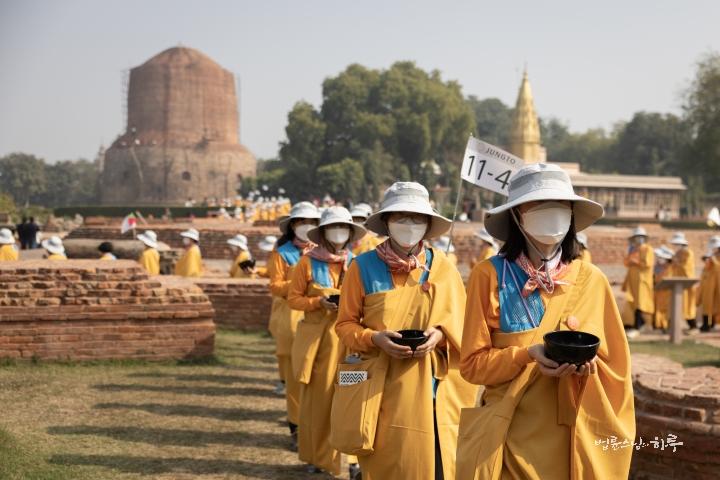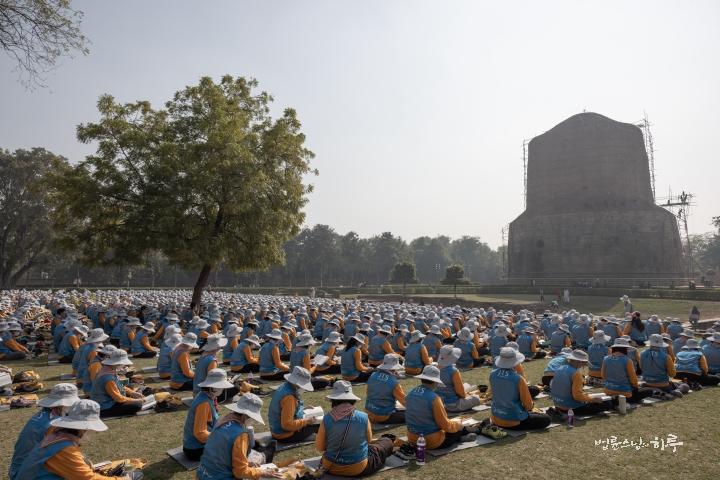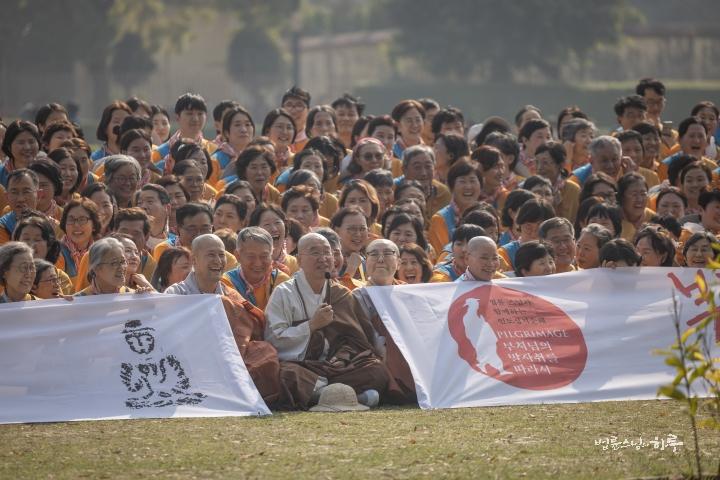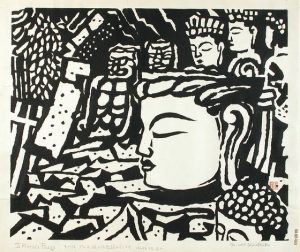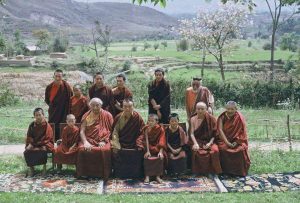
In the early 1990s, a Buddhist monk traveled to India on a spiritual pilgrimage. The monk’s experiences while in India became a source of inspiration and resolve for the monk, leading him to plant the seeds of social outreach that would benefit the struggling and underprivileged in India many times over. That monk was Venerable Pomnyun Sunim (법륜스님),* a Korean Seon (Zen) master and social activist who has since earned renown in his native South Korea and around the world for his insightful yet accessible Dharma instruction and for his far-reaching humanitarian activities and projects as a socially engaged Buddhist.
Ven. Pomnyun Sunim has returned to India many times since that fateful pilgrimage. Most frequently, his visits are centered on the work of the international Buddhist relief organization he founded, Join Together Society (JTS), and its Indian office JTS India, which endeavors to lift the lives of the people of Dungeshwari, Bihar, some 12 kilometers northeast of Bodh Gaya, out of hunger, illiteracy, and disease by working directly with communities and teaching them to mobilize their own capabilities and resources.
Echoing those first portentous footsteps that traced the legacy of the historical Buddha, and led to the founding of a modern legacy of engaged Buddhism, Ven. Pomnyun Sunim led 1,250 practitioners—members of Jungto Society, the international Buddhist community he founded—on a pilgrimage to India and Nepal from 29 January–10 February.
Jungto Society is a volunteer-run community and humanitarian organization that aspires to embody the Buddhist teachings through social engagement, and by promoting a simple lifestyle centered on sustainable living. Jungto Society seeks to address the crises of modern society, such as greed, poverty, conflict, and environmental degradation, by applying a Buddhist worldview of interconnectedness and living in line with the principle that everyone can find happiness through Buddhist practice and active participation in social movements.
Leading 1,250 Jungto members this year was of particular importance: as well as the privilege of connecting directly with the ancient heritage of the 2,600-year-old spiritual tradition of Shakyamuni Buddha, January marked 30 years since Ven. Pomnyun Sunim’s first visit to India and also the completion of Jungto Society’s 30-year 10,000-day practice, which Jungto members undertake with the aim of changing themselves and the society in which they live for the better by living the life of a Mahayana bodhisattva through practice, donation, and volunteer work.
To commemorate this auspicious occasion, Ven. Pomnyun Sunim led the 1,250 pilgrims from Seoul to New Delhi and then on to numerous sacred landmarks in Varanasi, Sarnath, Dhungeshwari, Bodh Gaya, Jethian, Venu Van, Vulture Peak, Vaishali, Kesariya, and Kushinagar in India. The practitioners then moved onward to visit sacred sites Lumbini, Nepal, before returning to India to continue their pilgrimage in Sravasti, Jetavana, and Sankissa.
After arriving in India and making their way to Sarnath, Ven. Pomnyun Sunim addressed the pilgrims: “Good morning! Today is the day that we begin our pilgrimage retracing the footsteps of the Buddha, beginning in Sarnath, where the Buddha gave his first sermon after his awakening.”
After completing morning practice and meditation, Ven. Pomnyun Sunim led the Jungto members in loading boxes of communal items and other essentials onto their buses for delivery to the residents of Dungeshwari.
For logistical ease, the 1,250 pilgrims were divided into two teams. Thus, team A would depart for each pilgrimage site several hours before team B. And once the second team arrived at a site, all 1,250 pilgrims would hold a Dharma meeting with Ven. Pomnyun Sunim.
For the Dharma meeting in Sarnath, the 1,250 pilgrims assembled around Dhamek Stupa at 10:30 a.m.
“This is Sarnath, where the Buddha gave his first sermon,” Ven. Pomnyun Sunim explained, “Sarnath was part of the city of Varanasi and the kingdom of Varanasi during the Buddha’s lifetime. It was called Kashi at the time. It has a history of some 3,000 years and is today known asVaranasi. Many cities of the Buddha’s lifetime were destroyed or have long since disappeared, but Varanasi still thrives and is also considered the most important Hindu pilgrimage site.”
“The bodies of middle- and upper-caste people were cremated on the shores of the Ganga [Ganges], but those of the lower castes and untouchables were discarded in the forests. This custom is similar to the traditional Korean burial custom of the old days, when graves were not made for people of the lower classes. This place, about six kilometers north of Varanasi, was a forest where corpses were left. Forests for corpses were considered polluted and couldn’t be located near cities. People rarely visited these places and thus ascetics found that they could practice there in silence. Forests used for corpse disposal were called Sitavana.
“This place was Sitavana for the residents of Varanasi. And it was here that the Buddha gave his first sermon. It was considered the most tainted place where corpses were discarded, and now it is considered the most sacred place because the Buddha gave his first teaching here.
“Upon entering Sarnath, you can see a large circle on the ground to your left. This is the site where the Buddha set the Wheel of Dharma in motion. It is called Dharmarajika Stupa. Dharma means the law or the right way of living and rajika means wheel. So Dharmarajika means the Wheel of Dharma.”
“A stupa was built to memorialize the Buddha’s first sermon here, but a Hindu king toppled the monument and used the bricks to build a palace. It is said that a container was excavated from the stupa but that its contents were scattered in the river. Probably it contained the remains of the Buddha. That stupa no longer exists but this place is still remembered as the site of the Buddha’s first sermon.
“After attaining enlightenment, the Buddha thought about who would best understand the Dharma and his thoughts turned to his five companion ascetics who had practiced with him before. They were practicing in Sarnath at the time. After listening to the Buddha’s first sermon, Kaundinya attained enlightenment first among the five. The Buddha continued his teaching for a week for the other four. Two more ascetics attained enlightenment three days after Kaundinya, and then the last two attained enlightenment three days after that. Hence all five were enlightened in a week.
“Bodh Gaya is the place where the Buddha, the one who attained enlightenment on his own, appeared. And Sarnath is the place where the first person to become enlightened after listening to the Buddha’s teaching appeared. These days, ‘sangha’ means a community of ordained monks, but its original meaning was a community of people who were enlightened after listening to the Dharma. The person who was enlightened on his own is the Buddha. The Buddha’s teaching to awaken unenlightened beings is the Dharma. And a community of people who are enlightened after listening to the Dharma is the Sangha. Sangha is a plural noun denoting more than one enlightened person. Thus, the Three Jewels of the Buddha, the Dharma, and the Sangha were established here.”
“The stupa you see behind me is Dhamekh Stupa. After Kaundinya attained enlightenment, the Buddha continued his sermons for the four ascetics, and this is where the second sermon was given.
“After the Buddha set the Wheel of Dharma in motion, many ascetics came here to practice. At first, there was no monastery but later Deer Park Monastery was built. In Hindi, it is called Mulagandhakuti Vihara. Because of the Ashoka pillar at Mulagandhakuti, it was possible to identify this place as the site of the Buddha’s first sermon. Four lions are carved on the capital of the pillar, which was adopted as the national emblem of India; the national emblem of India originated in Sarnath.”
The 1,250 Jungto pilgrims proceeded to recite the part of the sutra that describes the Buddha’s first sermon at Sarnath, and then meditated while visualizing the scene of the Buddha giving his sermon to the five ascetics in that historic ands venerated setting.
Ven. Pomnyun Sunim then led a precepts ceremony at the site of the Buddha’s first sermon.
“For the precepts ceremony, hold the mindset that you will practice diligently as a lay practitioner—such as the father of the venerable bhikshu Yasa if you are a man, and like Yasa’s wife and mother if you are a woman. Live as a practitioner from the moment you receive a robe and a bowl today until you return them in Sankissa.”
The 1,250 pilgrims received moxibustion, a symbolic act of repentance for their past wrongs and as a vow to observe the Buddhist precepts. Ven. Pomnyun Sunim then explained the meaning behind the robe and bowl.
“You are not tourists today, but pilgrims. So from this moment on, you should keep the mindset of a practitioner. Receiving the bowl symbolizes your vow not to be bothered by the food you eat. Have the mindset that you will beg for alms food. Receiving the robe symbolizes your vow not to be bothered by where you sleep. Have the mindset that you will wear a robe made of rags and sleep under a tree. In Zen Buddhism, the bowl and robe were used as symbols of Dharma transmission. By receiving the bowl and robe, you are making a vow to live frugally and humbly.”
After the ceremony, Ven. Pomnyun Sunim gave a talk on the significance of beginning the pilgrimage from Sarnath.
“When did the Buddha become a buddha? Some say that he was born a buddha, but to be precise, he wasn’t yet a buddha when he was born. A ‘buddha’ means one who is enlightened on his own, so one has to first attain enlightenment to be a buddha. Therefore, the Buddha became a buddha in Bodh Gaya, where he attained enlightenment.
“Yet even if there is a buddha, unenlightened beings won’t recognize the existence of the buddha unless they receive teachings. Therefore, from the standpoint of unenlightened beings, Sarnath, where the Buddha gave his first sermon, is where the Buddha first appeared in the world. The one who gave teachings to lead unenlightened beings to enlightenment appeared for the first time here in Sarnath. For this reason, we begin our pilgrimage in Sarnath.
“Sarnath is important for us not only because the Buddha gave his first sermon here, but also because lay practitioners, who practice while living as householders, appeared here first. The first lay practitioners were Ven. Yasa’s father and mother.
“Sarnath is where the Three Jewels of the Buddha, the Dharma, and the Sangha were established, and where lay practitioners appeared for the first time. The first upasaka, a male lay practitioner, was Yasa’s father, and the first upasikas, female lay practitioners, were Yasa’s mother and wife. In this sense, Sarnath is very meaningful.
“The Buddha also ordained Yasa and 54 of his friends here. Four of Yasa’s friends from Varanasi came to look for Yasa, but after listening to the Buddha’s teaching, they took refuge in the Buddha. At the time, there were about 300 kingdoms in India, and 50 of Yasa’s friends from various kingdoms came looking for Yasa and the four friends, fearing that something might have happened to them. But after listening to the Buddha’s teaching, they also joined the Sangha. As a result, 55 people were ordained. This brought the number of enlightened beings to 61: the five bhikshus the Buddha first ordained, Yasa, and his 54 friends, and the Buddha himself. It was at this stage that the Buddha urged his disciples to spread the Dharma.
“Yasa’s father, mother, and wife were lay practitioners like you, so bear in mind the significance of the establishment here of the Threefold Refuge and the Five Precepts. The Threefold Refuge and the Five Precepts are not for ordained monks; these are for lay practitioners who practice while living as householders.
“Nirvana means being free from all suffering. It is a state of no afflictions; no sorrow, hatred, resentment, worry, anxiety, or anguish. But it is not a state of excitement. It was very difficult to explain this state to people who had never experienced it. It is the same today. Instead of pursuing or staying in a state without any suffering, you pursue enjoyment. As a result, you’re unable to escape suffering.”
“The Buddha looked for his companions to share the Dharma that he had realized. He came all the way to Sarnath to share the Dharma. We might think that people would scramble to meet a fully enlightened one such as the Buddha, but contrary to our assumption, the Buddha came here looking for people with ears to listen.
“His friends, who had practiced with him for six years, were absorbed in asceticism. When you practice asceticism, you deny all bodily pleasures: first, not washing your body; second, not eating soft foods; third, not being choosy about where to sit or lie. After realizing that the path to awakening was the middle way, the Buddha took a bath in the river, ate milk-rice porridge, sat on grass obtained from a herder, and meditated under a tree. When the five ascetics saw the Buddha acting this way, they thought he had abandoned his practice.
“It’s not that the Buddha had bathed in warm, scented water, he simply bathed in the river; it’s not that he desired all kinds of food, he just ate porridge after a long fast and sat on an armful of ordinary grass obtained from a herder. But in the eyes of those ascetics, he appeared to be pursuing bodily pleasures.”
“However, the Buddha perceived that neither the pursuit of bodily pleasures nor the mortification of the body is the path to enlightenment. Instead, he discovered the Middle Way, recognizing desires as they are.
“The important thing is not the food, clothing, or shelter, but exploring and investigating the cause of suffering and removing it. Only then can you attain liberation. But if we form and cling to a notion of liberation, we will suffer again even after attaining liberation. Therefore, we make a vow not to suffer again and to maintain the eight right perspectives in our daily lives. These eight right perspectives make up the Noble Eightfold Path.
“Keep your mind and body at ease without becoming excited or tense; be aware of the workings of your mind and body, and be unhindered by them; and restrain your speech, thoughts, and conduct in everyday life. Then, wisdom and right thought will arise within you. Only then can you be free from suffering. Even if you suffer because of momentary clinging, you can recognize it and escape from it right away. Even if anger, irritation, hatred, resentment, sorrow, worry, or anxiety arise, you can recognize right away that you’ve missed its arising and restore equanimity.
“After listening to the Buddha’s teachings on the Middle Way, the Four Noble Truths, and the Noble Eightfold Path, Kaundinya was instantly lifted out of the darkness. Realizing the profundity of the Dharma, Kaundinya rose and bowed to the Buddha. He showed respect to the Buddha as his teacher. It is said that the Buddha was happier when Kaundinya was awakened than when he himself was awakened, and he exclaimed: ‘Kaundinya has understood the Dharma!’ Because it proved that not only himself but also others could attain enlightenment.”
“The other four ascetics were baffled as to why a friend would bow to a friend, but the dialogue continued for three more days with questions and answers. And two more ascetics were enlightened. In another three days, two more ascetics were enlightened. Thus all five ascetics were enlightened in a week.
“Through this, the path to liberation, the path to freedom, the path to becoming one’s own master was laid out for the people of the world for the first time. Determinism—whether it is claimed that one’s life is determined by past lives, by god, or by the time of birth—was the dominant ideology at the time. This meant that there was no escape from suffering. To escape from suffering, Hinduism claimed that one needed to make sacrifices to the gods. Some claimed that one needed to bathe in the Ganga. And yet others claimed that one needed to pray to the gods. But the Buddha taught that we can escape from suffering by identifying and removing the causes of suffering.
“This profound Dharma started here in Sarnath and began to reverberate around the world. The five ascetics had been practicing for a long time. But Yasa was a young man, a man in pursuit of pleasures—the five strands of sense pleasure—but he was enlightened after listening to the Buddha’s teaching only once. It was because he realized that pleasure is suffering. Because of his enlightenment, his father, mother, and wife also took the path to liberation and nirvana as lay practitioners. The path to becoming a practitioner who understands the Dharma was laid out here in Sarnath for the first time.
“This is the place where the Buddha set the Wheel of Dharma in motion and blew the horn of the Dharma. So, let’s make a vow here:
Let’s guide people to this Dharma so that they can live a life free of suffering as the masters of their own lives under any circumstances, without blaming others, or heaven, or their past lives, or time of birth, or the world.
“Here in Sarnath, where the Buddha blew the horn of the Dharma, let’s vow to spread the Dharma around the world. Let’s take refuge in the Three Jewels and receive the Five Precepts, just as Yasa’s father and wife did, and, here today, let we 1,250 practitioners declare our vow to spread the Dharma far and wide, just as the Buddha and his 60 disciples did.
“For the next 15 days, let our minds not be swayed by circumstances, even if we shiver in the morning, sweat during the day, feel hungry, or feel sleepy for lack of sleep. I hope you undertake this pilgrimage as would 1,250 arhats at the time of the Buddha, by keeping your mind wide awake.
“If you maintain this perspective, this pilgrimage will be a practice and a joy. But if you cling to bodily comfort, you are likely to complain, to regret your decision to be here, or to hate me, even if you said that you respected me before. I hope that you and I manage our minds well so that we become good Dharma friends rather than enemies after coming all the way here.”
The 1,250 pilgrims then recited the vow to spread the Dharma, and sang “Aspirations of Bodhisattva Samantabhadra.” Lastly, Ven. Pomnyun Sunim prayed for the fulfillment of the vow.
“Today, we 1,250 Jungto practitioners made a vow and pledged in front of Dhamekh Stupa in Deer Park, Sarnath, as we begin our pilgrimage retracing the footsteps of the Buddha.
“The Buddha awakened the five ascetics, Yasa, and his friends, his mother, his father, and his wife. And in the same way, we will lead our families and acquaintances to this wonderful Dharma.
“Just as the Buddha urged the 60 arhats to spread the Dharma, we 1,250 practitioners vow to spread the Dharma around the world following the Buddha’s teachings.
“We vow to spread the Dharma to every corner of Korea, to the world, to any place where there is suffering.
“For the merit of making this vow, may all buddhas and bodhisattvas help us to eradicate all the karma we’ve accumulated, to continue our practice, and to spread the Dharma. And may heaven and all holy beings protect us to fulfill our vow.”
Clad in their yellow robes and with their bowls in hand, the 1,250 pilgrims circumambulated Dhamekh Stupa, around Dharmarajika Stupa, past the Ashoka pillar, around Mulagandhakuti Vihara, before returning to where they started.
Sarnath was awash with waves of yellow robes as the pilgrims earnestly recited the Threefold Refuge in Pali:
Buddham saranam gacchami
Dhammam saranam gacchami
Sangham saranam gacchami

Thus dedicated, the minds of the 1,250 pilgrims were prepared and the pilgrimage could continue with open and earnest hearts as the pilgrims undertook the 7-1/2-hour journey to the next stop, Dungeshwari, where Ven. Pomnyun Sunim has been working to empower the local Dalit community.
Arriving in Dungeshwari, the Jungto practitioners received a warm and rousing welcome from the local children, students of Sujata Academy, a community school established by JTS India to provide preschool, elementary, and technical education.**
Tuition at Sujata Academy is provided free of charge for destitute children. Its principal goal is to equip every student with basic literacy skills. Classes are taught from kindergarten to secondary level, along with adult literacy classes and skills training. Students of the academy who wish to continue beyond elementary education and attend secondary school are required to help teach kindergarteners or to assist in the JTS medical clinic, working in the spirit of giving back to the community.
While in Dungeshwari the 1,250 Jungto practitioners were able to visit the next stops in their pilgrimage: Pragbodhi Mountain and the Dungeshwari cave complex, where Prince Siddhartha practiced austerities for six years prior to attaining enlightenment.
While bonding with the local residents amid welcome ceremonies and cultural performances by the children, who formed the beating heart of a celebration for the 29th anniversary of Sujata Academy, the practitioners served a meal to 10,000 local residents from nearby villages, in the spirit of the young woman Sujata offering a meal of milk-rice to the emaciated Siddhartha.
It was this meal, offered by Sujata in a selfless gesture of generosity and kindness, that gave the Buddha with the strength he needed to continue meditating and to ultimately attain enlightenment. It was this meal, offered by Sujata that demonstrated the power of generosity and compassion to transform our lives and the lives of others.
Thus fortified in body, heart, and spirit, the 1,250 pilgrims were ready to continue onward on their pilgrimage in the true spirit of the Dharma—to Bodh Gaya, the site of the Buddha’s awakening, and the next chapter of their spiritual journey.
* The Hungry Should Eat: JTS Brings Buddhist Compassion and Relief to India (BDG)
** Engaged Buddhism: Ven. Pomnyun Sunim and JTS Volunteers Visit Sujata Academy Project in India (BDG)
See more
Pomnyun
Jungto Society
JTS Korea
JTS America
International Network of Engaged Buddhists (INEB)
Related features from BDG
Ven. Pomnyun Sunim: Buddhism in a Divided World
Dharma Q+A with Ven. Pomnyun Sunim: Facing the Challenges of COVID-19 Lockdown
The Hungry Should Eat: JTS Brings Buddhist Compassion and Relief to India
Engaged Buddhism: Seon Master Pomnyun Sunim Pledges 10,000 Tons of Food Aid for Children in North Korea
Engaging with Suffering, Realizing Freedom: An Interview with Ven. Pomnyun Sunim
Related videos from BDG
Dharma Q+A with Ven. Pomnyun Sunim
Wisdom Notes from Ven. Pomnyun Sunim
Related news reports from BDG
Online Dharma: Jungto Society Announces New Intake for Jungto Dharma School with Ven. Pomnyun Sunim
Engaged Buddhism: Ven. Pomnyun Sunim Shares the Fruits of Compassion to Mark the Birth of the Buddha
Engaged Buddhism: Ven. Pomnyun Sunim Delivers Compassion to the Vulnerable in Korea
Engaged Buddhism: Jungto Society Delivers Compassion for the Vulnerable in Korea
Engaged Buddhism: JTS Korea Distributes Emergency Flood Relief in Cambodia
Engaged Buddhism: JTS Korea Donates COVID-19 Relief Supplies to Myanmar in Cooperation with INEB and KMF
Engaged Buddhism: Jungto Society Sharing the Gift of Compassion this Winter
UPDATE: Buddhist Relief from JTS Korea Transforming the Lives of Rohingya Refugees
Engaged Buddhism: JTS Korea Brings Warmth to Vulnerable Communities amid Winter Freeze







